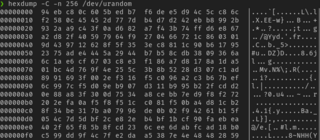
A cryptographic hash function (CHF) is a hash algorithm that has special properties desirable for a cryptographic application:

passwd is a command on Unix, Plan 9, Inferno, and most Unix-like operating systems used to change a user's password. The password entered by the user is run through a key derivation function to create a hashed version of the new password, which is saved. Only the hashed version is stored; the entered password is not saved for security reasons.
In information technology, a backup, or data backup is a copy of computer data taken and stored elsewhere so that it may be used to restore the original after a data loss event. The verb form, referring to the process of doing so, is "back up", whereas the noun and adjective form is "backup". Backups can be used to recover data after its loss from data deletion or corruption, or to recover data from an earlier time. Backups provide a simple form of IT disaster recovery; however not all backup systems are able to reconstitute a computer system or other complex configuration such as a computer cluster, active directory server, or database server.
Hashcash is a proof-of-work system used to limit email spam and denial-of-service attacks. Hashcash was proposed in 1997 by Adam Back and described more formally in Back's 2002 paper "Hashcash – A Denial of Service Counter-Measure". In Hashcash the client has to concatenate a random number with a string several times and hash this new string. It then has to do so over and over until a hash beginning with a certain number of zeros is found.
The Encrypting File System (EFS) on Microsoft Windows is a feature introduced in version 3.0 of NTFS that provides filesystem-level encryption. The technology enables files to be transparently encrypted to protect confidential data from attackers with physical access to the computer.

In Unix-like operating systems, /dev/random and /dev/urandom are special files that serve as cryptographically secure pseudorandom number generators (CSPRNGs). They allow access to a CSPRNG that is seeded with entropy from environmental noise, collected from device drivers and other sources. /dev/random typically blocked if there was less entropy available than requested; more recently it usually blocks at startup until sufficient entropy has been gathered, then unblocks permanently. The /dev/urandom device typically was never a blocking device, even if the pseudorandom number generator seed was not fully initialized with entropy since boot. Not all operating systems implement the same methods for /dev/random and /dev/urandom.
Filesystem in Userspace (FUSE) is a software interface for Unix and Unix-like computer operating systems that lets non-privileged users create their own file systems without editing kernel code. This is achieved by running file system code in user space while the FUSE module provides only a bridge to the actual kernel interfaces.

Digest access authentication is one of the agreed-upon methods a web server can use to negotiate credentials, such as username or password, with a user's web browser. This can be used to confirm the identity of a user before sending sensitive information, such as online banking transaction history. It applies a hash function to the username and password before sending them over the network. In contrast, basic access authentication uses the easily reversible Base64 encoding instead of hashing, making it non-secure unless used in conjunction with TLS.
Fossil is the default file system in Plan 9 from Bell Labs. It serves the network protocol 9P and runs as a user space daemon, like most Plan 9 file servers. Fossil is different from most other file systems due to its snapshot/archival feature. It can take snapshots of the entire file system on command or automatically. These snapshots can be kept on the Fossil partition as long as disk space allows; if the partition fills up then old snapshots will be removed to free up disk space. A snapshot can also be saved permanently to Venti. Fossil and Venti are typically installed together.
Content-addressable storage (CAS), also referred to as content-addressed storage or fixed-content storage, is a way to store information so it can be retrieved based on its content, not its name or location. It has been used for high-speed storage and retrieval of fixed content, such as documents stored for compliance with government regulations. Content-addressable storage is similar to content-addressable memory.
In computer science, storage virtualization is "the process of presenting a logical view of the physical storage resources to" a host computer system, "treating all storage media in the enterprise as a single pool of storage."
sha1sum is a computer program that calculates and verifies SHA-1 hashes. It is commonly used to verify the integrity of files. It is installed by default on most Linux distributions. Typically distributed alongside sha1sum are sha224sum, sha256sum, sha384sum and sha512sum, which use a specific SHA-2 hash function and b2sum, which uses the BLAKE2 cryptographic hash function.
In public-key cryptography, a public key fingerprint is a short sequence of bytes used to identify a longer public key. Fingerprints are created by applying a cryptographic hash function to a public key. Since fingerprints are shorter than the keys they refer to, they can be used to simplify certain key management tasks. In Microsoft software, "thumbprint" is used instead of "fingerprint."

Magma is a distributed file system based on a distributed hash table, written in C, compatible with Linux and BSD kernels using FUSE.
In computing, data deduplication is a technique for eliminating duplicate copies of repeating data. Successful implementation of the technique can improve storage utilization, which may in turn lower capital expenditure by reducing the overall amount of storage media required to meet storage capacity needs. It can also be applied to network data transfers to reduce the number of bytes that must be sent.
SipHash is an add–rotate–xor (ARX) based family of pseudorandom functions created by Jean-Philippe Aumasson and Daniel J. Bernstein in 2012, in response to a spate of "hash flooding" denial-of-service attacks (HashDoS) in late 2011.
crypt is a POSIX C library function. It is typically used to compute the hash of user account passwords. The function outputs a text string which also encodes the salt, and identifies the hash algorithm used. This output string forms a password record, which is usually stored in a text file.
Synnefo is a complete open-source cloud stack written in Python that provides Compute, Network, Image, Volume and Storage services, similar to the ones offered by AWS. Synnefo manages multiple Google Ganeti clusters at the backend that handle low-level VM operations and uses Archipelago to unify cloud storage. To boost 3rd-party compatibility, Synnefo exposes the OpenStack APIs to users.
ZFS is a file system with volume management capabilities. It began as part of the Sun Microsystems Solaris operating system in 2001. Large parts of Solaris, including ZFS, were published under an open source license as OpenSolaris for around 5 years from 2005 before being placed under a closed source license when Oracle Corporation acquired Sun in 2009–2010. During 2005 to 2010, the open source version of ZFS was ported to Linux, Mac OS X and FreeBSD. In 2010, the illumos project forked a recent version of OpenSolaris, including ZFS, to continue its development as an open source project. In 2013, OpenZFS was founded to coordinate the development of open source ZFS. OpenZFS maintains and manages the core ZFS code, while organizations using ZFS maintain the specific code and validation processes required for ZFS to integrate within their systems. OpenZFS is widely used in Unix-like systems.




